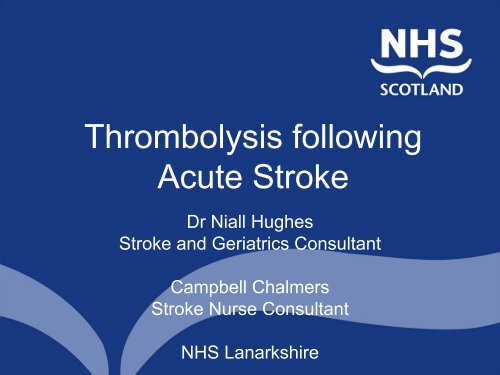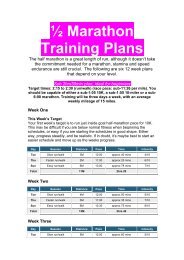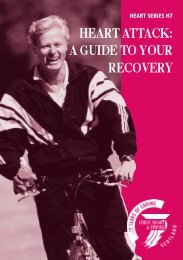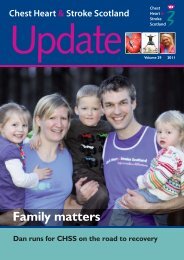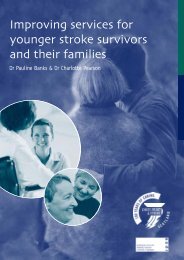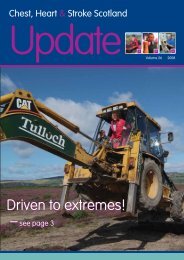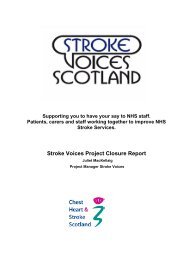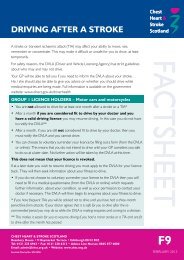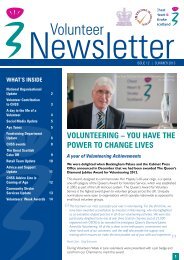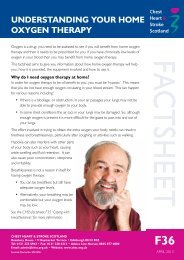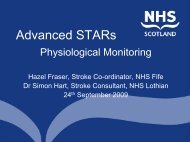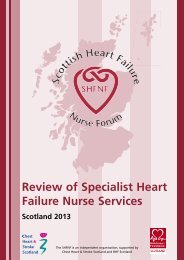Rationale for Thrombolysis
Rationale for Thrombolysis
Rationale for Thrombolysis
You also want an ePaper? Increase the reach of your titles
YUMPU automatically turns print PDFs into web optimized ePapers that Google loves.
<strong>Thrombolysis</strong> following<br />
Acute Stroke<br />
Dr Niall Hughes<br />
Stroke and Geriatrics Consultant<br />
Campbell Chalmers<br />
Stroke Nurse Consultant<br />
NHS Lanarkshire
<strong>Rationale</strong> <strong>for</strong> <strong>Thrombolysis</strong><br />
• Thromboembolic occlusion (85% strokes) → drop in blood flow<br />
in corresponding arterial territory<br />
• Flow ~ 20 ml/100 g /minute (~40% of the normal) → sx<br />
• 1 million neurons die each minute<br />
• 10 - 20 ml/100g/min → may survive <strong>for</strong> a few hours, but likely<br />
to die if blood flow is not re-established<br />
• Spontaneous reperfusion may occur through endogenous<br />
release of plasminogen activator (stimulates plasminogen →<br />
plasmin)
Trial Evidence <strong>for</strong> Alteplase<br />
• Surprisingly little (relatively)<br />
• NINDS (1995) - alteplase 0.9mg/kg, treatment within 3 hours<br />
- ≥ 30% more likely to have min/no disability 3 mths<br />
- almost half treated
Pooled data analysis of NINDS, ATLANTIS and ECASS I and II trials (shaded gray) showing<br />
odds ratios and 95% confidence intervals <strong>for</strong> favorable outcome in different time windows from<br />
onset, adjusted <strong>for</strong> prognostic confounders, with ECASS III outcome [superimposed (shaded<br />
black)]
Reasons Patients Not Thrombolysed<br />
1) Failure to be assessed within 3 hours<br />
2) Concerns of physicians<br />
- Approval based on only one trial<br />
- benefits in NINDS due to no treated
Alteplase conditionally licenced<br />
by EMEA in Europe in 2002<br />
• Reflected these concerns<br />
• Two conditions<br />
1) - observational safety study<br />
- The Safe Implementation of <strong>Thrombolysis</strong><br />
in Stroke-Monitoring Study [SITS-MOST]<br />
- patients treated within licence terms<br />
(18-80, 25)<br />
2) - randomised trial with time window<br />
extended beyond 3 hours [ECASS 3]<br />
- initially 3-4 hrs, later changed to 3-4.5 hrs
SITS-MOST (2007)<br />
• Recruited from December 2002 – April 2006<br />
• 6,483 patients, 285 centres, 14 countries<br />
• Treated on average 140 mins (11%
Modified Rankin scores at 3 months<br />
0 1 2 3 4 5 Dead<br />
Pooled placebo<br />
0–3 h (n=465)<br />
14% 15% 11% 15% 20% 8% 17%<br />
Pooled alteplase<br />
0–3 h ( n=463)<br />
19% 23% 7% 14% 12% 7% 18%<br />
SITS-MOST<br />
(n=6,136)<br />
19% 20% 16% 15% 14% 5% 11%<br />
Modified Rankin scores at 3 months in SITS-MOST and randomised<br />
controlled trials <strong>for</strong> placebo and alteplase patients<br />
Wahlgren N et al Lancet 2007; 369: 275−282.
Conclusions<br />
• The results of SITS-MOST confirm that routine use of<br />
alteplase within 3 hours of ischaemic stroke has a safety<br />
profile at least as good as that seen in randomised<br />
controlled trials<br />
• Safety could be maintained across centres, regardless<br />
of experience in acute stroke thrombolysis<br />
• <strong>Thrombolysis</strong> should now be considered a part of routine<br />
care of suitable stroke patients
ECASS 3 (2008)<br />
• Initially 3-4 hours from onset (amended to 3-4.5 hours)<br />
• Confirmed benefits of IV alteplase between 3 & 4.5hrs<br />
• SICH 1.9% [SITS definition]
SIGN Guideline 108, 2008<br />
Grade A evidence<br />
• Patients admitted with stroke within four and a half<br />
hours of definite onset of symptoms, who are<br />
considered suitable, should be treated with 0.9mg/kg<br />
(up to maximum 90mg) intravenous alteplase<br />
• Onset to treatment time should be minimised.<br />
Systems should be optimised to allow the earliest<br />
possible delivery of treatment within the defined time<br />
window
“TIME IS BRAIN”<br />
Model estimating odds ratio <strong>for</strong> favourable outcome at 3 months in<br />
tPA treated patients compared with controls by onset to treatment
What I expect A+E to do<br />
1. Recognise this is a probable stroke ASAP (ROSIER)<br />
2. CONFIRM TIME OF ONSET ASAP<br />
3. Contact stroke team ASAP<br />
4. Arrange CT brain ASAP<br />
5. Do relevant urgent things ASAP:<br />
-BP<br />
- directed medical history ( contra-indications)<br />
- bloods and blood sugar<br />
- cannula
What I do<br />
1. Let ward know<br />
2. Get to A+E ASAP<br />
3. CONFIRM TIME OF ONSET<br />
4. Check <strong>for</strong> contra-indications<br />
5. Complete NIHSS<br />
6. Counsel patient/relatives (+/-consent), check weight<br />
7. Wheel them to CT
If no contraindication….<br />
• Dilute with sterile water<br />
to 1mg/ml<br />
• 10% of the total dose is<br />
administered as an<br />
initial intravenous bolus<br />
over 2 minutes<br />
• remaining 90% is<br />
administered as an<br />
infusion using syringe<br />
pump over 1 hour
Nursing Monitoring & Observation<br />
• Follow local protocols and guidelines<br />
• Identified Register Nurse trained in<br />
thrombolysis<br />
• Close acute monitoring of vital signs,<br />
GCS, NIHSS<br />
• Observe <strong>for</strong> signs of bleeding, raised<br />
intra-cranial pressure, anaphylaxis<br />
• Prevention of deterioration and<br />
complications<br />
• Repeat CT scan at 24 hours
Nursing Observation<br />
Observe <strong>for</strong> signs of bleeding:<br />
• Minor or major bleeding<br />
• Bruising<br />
• Existing injuries, wounds and IV cannula<br />
Observe <strong>for</strong> signs of raised intra-cranial pressure:<br />
• Onset of drowsiness<br />
• Irritability or agitation<br />
• Onset of nausea, vomiting or photophobia<br />
• New or increasing headache<br />
• Unequal pupils<br />
Observe <strong>for</strong> signs of anaphylaxis:<br />
• Angio-oedema: swelling of the tongue and lips
Nursing Care<br />
• Ensure safety and falls prevention<br />
• Bed rest with safety sides in situ (as<br />
appropriate) and a head position angle of<br />
30 degrees or gentle mobilisation with direct<br />
supervision<br />
• Supervised toileting at bedside<br />
• Oral care caution using toothbrushes and<br />
suctioning<br />
• Personal hygiene - avoid wet shaving<br />
• Skin care and regular position changes <strong>for</strong><br />
pressure relief<br />
• Care of IV cannula sites
Nursing Care<br />
• Avoid urinary catheterisation, NG tube<br />
insertion, central venous access, arterial<br />
puncture or other invasive procedures<br />
be<strong>for</strong>e treatment and <strong>for</strong> 24 hours after<br />
• Consult with medical colleagues if any<br />
invasive procedures are necessary<br />
• Care should be taken when removing<br />
urinary catheters<br />
• Avoid anti-platelets, anti-coagulants, non<br />
steroidal anti-inflammatories, sedatives or<br />
narcotics <strong>for</strong> 24 hours<br />
• Avoid giving IM injections <strong>for</strong> 48 hours
Methods of Organisational Delivery<br />
• Medical Approach<br />
• High Dependency Unit<br />
• Specialist or Research<br />
Nurse<br />
• Acute Stroke Unit<br />
(hyper-acute)<br />
• Use of Tele-medicine
Medical Approach<br />
Advantages<br />
• Specialist in stroke:<br />
skilled and<br />
experienced medical<br />
staff<br />
Challenges<br />
• Unpredictability<br />
• Sustainability<br />
• 24 hour service<br />
• Lack of skilled and<br />
experienced nurses in<br />
thrombolysis<br />
• Sufficient nursing<br />
resource<br />
• Bed availability
High Dependency Unit<br />
Advantages<br />
• Specialist in stroke:<br />
skilled and<br />
experienced medical<br />
staff<br />
• Skilled and<br />
experienced nursing<br />
staff in acutely ill<br />
patient / thrombolysis<br />
<strong>for</strong> MI<br />
Challenges<br />
• Unpredictability<br />
• Bed availability<br />
• Lack of early access to<br />
Stroke Unit<br />
• Lack of skilled and<br />
experienced stroke<br />
specialists<br />
• Step down <strong>for</strong> patients<br />
• Stroke nurses fail to<br />
gain experience in<br />
thrombolysis
Specialist or Research Nurse<br />
Advantages<br />
• Specialist in stroke:<br />
skilled and<br />
experienced<br />
medical staff and<br />
specialist or<br />
research nurse<br />
Challenges<br />
• Unpredictability<br />
• Sustainability<br />
• 24 hour service<br />
• Bed availability<br />
• Stroke nurses fail<br />
to gain experience<br />
in thrombolysis
Acute Stroke Unit (hyper-acute)<br />
Advantages<br />
• Early access to<br />
Stroke Unit<br />
• Access to multidisciplinary<br />
team<br />
• Specialists in<br />
stroke: skilled and<br />
experienced<br />
medical and<br />
nursing staff<br />
Challenges<br />
• Unpredictability<br />
• Identified register<br />
nurse trained in<br />
thrombolysis<br />
• Sufficient nursing<br />
resource<br />
• Bed availability
Use of Telemedicine<br />
• Tele-conferencing<br />
kit: location<br />
• Remote and rapid<br />
access to a oncall<br />
specialist stroke<br />
physician<br />
• Equity of access<br />
• Local access<br />
• Regional/national<br />
network
Acute Stroke: Patient Pathway<br />
• Early access to<br />
Stroke Unit<br />
• Acute assessment<br />
and monitoring<br />
• Access to multidisciplinary<br />
team<br />
• Specialists in<br />
stroke<br />
SIGN 108 (2008)<br />
Grade A evidence
Stroke Nursing Care<br />
• Acute assessment, observation and monitoring<br />
• Swallow screening, hydration and nutrition<br />
• Skin and oral care<br />
• Continence management (bladder and bowel)<br />
• Prevention of deterioration, complications and<br />
HAI’s<br />
• Access to multi-disciplinary team<br />
• Early activation and therapeutic handling<br />
• Goal setting and rehabilitation<br />
• Coordinated planned discharges
Patient and Carers<br />
• Verbal and written in<strong>for</strong>mation<br />
• Explains the benefits and risks<br />
• Can support decision making<br />
• Accessibility and <strong>for</strong>mats<br />
• Advice and support<br />
• Carer’s support<br />
and involvement
Case Study - John<br />
• 69 year old male<br />
• Lives in Lanarkshire<br />
• Married with a Son<br />
• PMH – Type II Diabetes, ex-smoker<br />
• Cycled to Lidl, to do some shopping<br />
• Collapsed and developed slurred<br />
speech, and left-sided face, arm and<br />
leg weakness<br />
• Ambulance called
Patient Pathway<br />
10.40am - Onset of symtpoms<br />
10.45am - Ambulance called<br />
11.40am - Arrived at A&E<br />
1 hour<br />
11.50am - Call to Stroke Consultant<br />
NIHSS 9<br />
1hr 10 mins<br />
12.10pm - CT Scan – NAD 1hr 30 mins<br />
No contraindications<br />
12.20pm – IV Bolus<br />
12.25pm - Infusion commenced<br />
1hr 40 mins
Aftercare<br />
• Rare anaphylactic reaction<br />
• Developed unilateral tongue<br />
swelling, breathlessness and<br />
tachycardia<br />
• Compromised airway – anaesthetist<br />
called<br />
• Treatment as per algorithm
Aftercare<br />
• Good recovery and returned home<br />
• Followed up by Stroke Liaison Nurse<br />
• Experienced tiredness initially and a<br />
weaker voice<br />
• Has returned to cycling and bowling
Patient Experience of<br />
<strong>Thrombolysis</strong> following Stroke<br />
Insert screen shot of Node 29846
Challenges <strong>for</strong> Stroke Nursing<br />
• Register Nurses trained in<br />
thrombolysis treatment / NIHSS<br />
• Sufficient nursing resource<br />
• 24 hour service, 7days per week<br />
• Unpredictability<br />
• Bed availability
Benefits of <strong>Thrombolysis</strong> Treatment<br />
• Improved outcome <strong>for</strong> patients – reduced death<br />
and disability<br />
• Early access to the acute stroke unit<br />
• Improved acute management<br />
• Improved development and retention of stroke<br />
nursing staff
<strong>Thrombolysis</strong> following<br />
Acute Stroke<br />
Dr Niall Hughes<br />
Stroke and Geriatrics Consultant<br />
Campbell Chalmers<br />
Stroke Nurse Consultant<br />
NHS Lanarkshire


